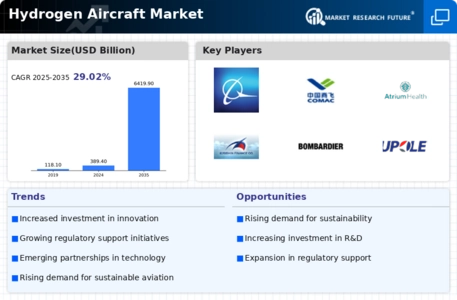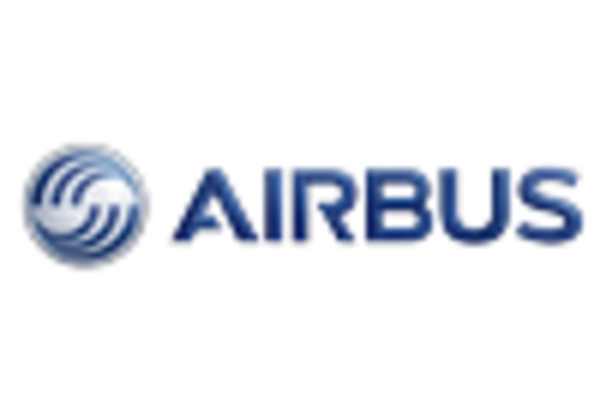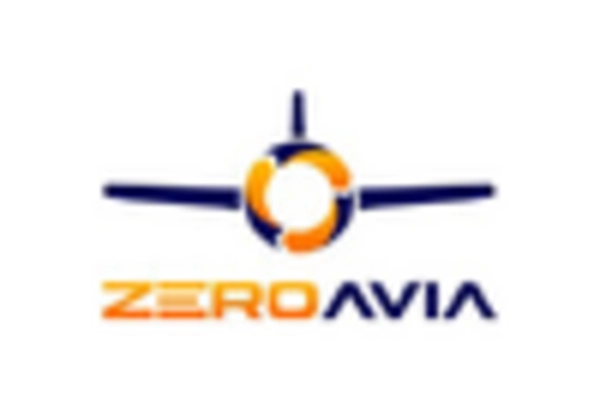The Hydrogen Aircraft Market is currently characterized by a dynamic competitive landscape, driven by the urgent need for sustainable aviation solutions and advancements in hydrogen technology. Key players such as Airbus (FR), Boeing (US), and ZeroAvia (GB) are at the forefront, each adopting distinct strategies to enhance their market positioning. Airbus (FR) has focused on innovation through its ZEROe initiative, which aims to develop the world’s first zero-emission commercial aircraft by 2035. Boeing (US), on the other hand, is leveraging its extensive experience in aerospace to explore hydrogen fuel cell technology, indicating a strategic pivot towards cleaner aviation solutions. Meanwhile, ZeroAvia (GB) is concentrating on partnerships and collaborations, particularly with regional airlines, to accelerate the adoption of hydrogen-powered aircraft, thereby shaping a competitive environment that emphasizes technological advancement and strategic alliances.
In terms of business tactics, companies are increasingly localizing manufacturing and optimizing supply chains to enhance efficiency and reduce costs. The Hydrogen Aircraft Market appears moderately fragmented, with a mix of established aerospace giants and innovative startups. This structure allows for a diverse range of strategies, where established players leverage their resources while newer entrants focus on niche innovations. The collective influence of these key players is likely to drive the market towards a more integrated approach to hydrogen aviation, fostering collaboration and shared technological advancements.
In August 2025, Airbus (FR) announced a partnership with a leading hydrogen fuel supplier to develop a comprehensive refueling infrastructure for its upcoming hydrogen aircraft. This strategic move is significant as it not only supports Airbus's commitment to sustainability but also addresses one of the critical challenges in the adoption of hydrogen technology—refueling logistics. By establishing a robust supply chain for hydrogen, Airbus positions itself as a leader in the market, potentially influencing other manufacturers to follow suit.
In September 2025, ZeroAvia (GB) successfully completed a test flight of its hydrogen-powered aircraft, marking a pivotal milestone in its operational strategy. This achievement underscores ZeroAvia's focus on practical applications of hydrogen technology and its commitment to demonstrating the viability of hydrogen as a fuel source for commercial aviation. The successful test flight is likely to enhance investor confidence and attract further partnerships, solidifying ZeroAvia's competitive edge in the market.
In October 2025, Boeing (US) revealed its plans to invest in a new research facility dedicated to hydrogen propulsion systems. This initiative reflects Boeing's long-term vision of integrating hydrogen technology into its aircraft designs. The establishment of this facility is expected to accelerate research and development efforts, positioning Boeing to compete effectively in a market that is increasingly prioritizing sustainable aviation solutions.
As of October 2025, the competitive trends in the Hydrogen Aircraft Market are heavily influenced by digitalization, sustainability, and the integration of advanced technologies such as AI. Strategic alliances are becoming increasingly vital, as companies recognize the need for collaboration to overcome the challenges associated with hydrogen aviation. Looking ahead, it is anticipated that competitive differentiation will evolve, shifting from traditional price-based competition to a focus on innovation, technological advancements, and the reliability of supply chains. This transition may redefine the competitive landscape, fostering a new era of sustainable aviation.


















Leave a Comment